An Evaluation of ALDI's Operations for Summer 2019
VerifiedAdded on 2023/01/18
|17
|3385
|58
Report
AI Summary
This report provides a comprehensive evaluation of ALDI's operations management. It begins with an overview of ALDI's strategic operations model, emphasizing its "Input process output system" and focus on cost leadership. The report then analyzes ALDI's approach to supply chain management, highlighting how it maintains efficiency and low costs. Part A discusses ALDI's strategic operations model, order winning criteria, and the roles of internal and external consumers. The report also examines strategic improvement approaches at different operational levels, including lean management principles. Part B assesses ALDI's guiding principle of providing great quality at low prices and evaluates the activities undertaken through the lean model. It discusses the implementation of just-in-time production, total quality management and time based management, and how these contribute to cost reduction and operational efficiency. The report references key academic sources to support its analysis.
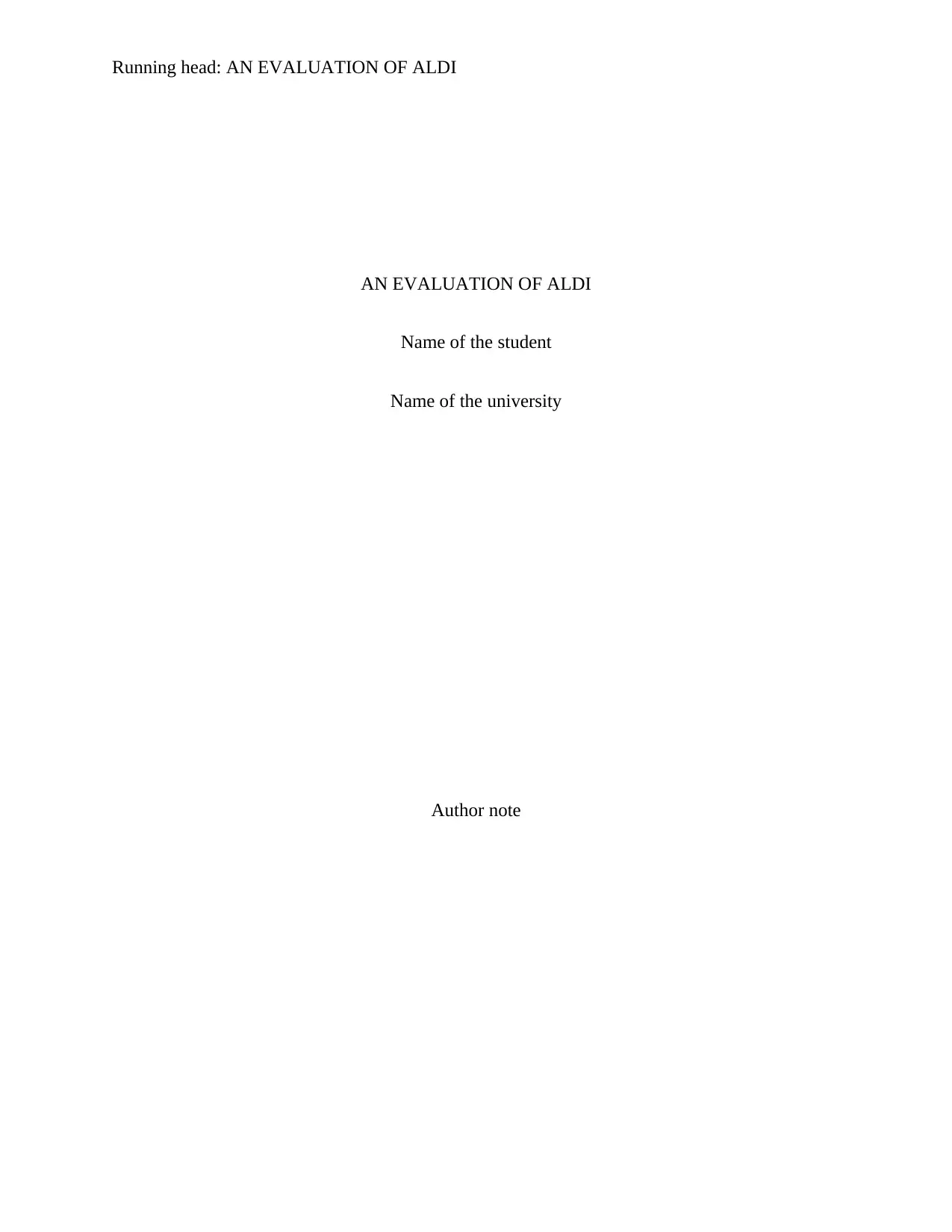
Running head: AN EVALUATION OF ALDI
AN EVALUATION OF ALDI
Name of the student
Name of the university
Author note
AN EVALUATION OF ALDI
Name of the student
Name of the university
Author note
Paraphrase This Document
Need a fresh take? Get an instant paraphrase of this document with our AI Paraphraser
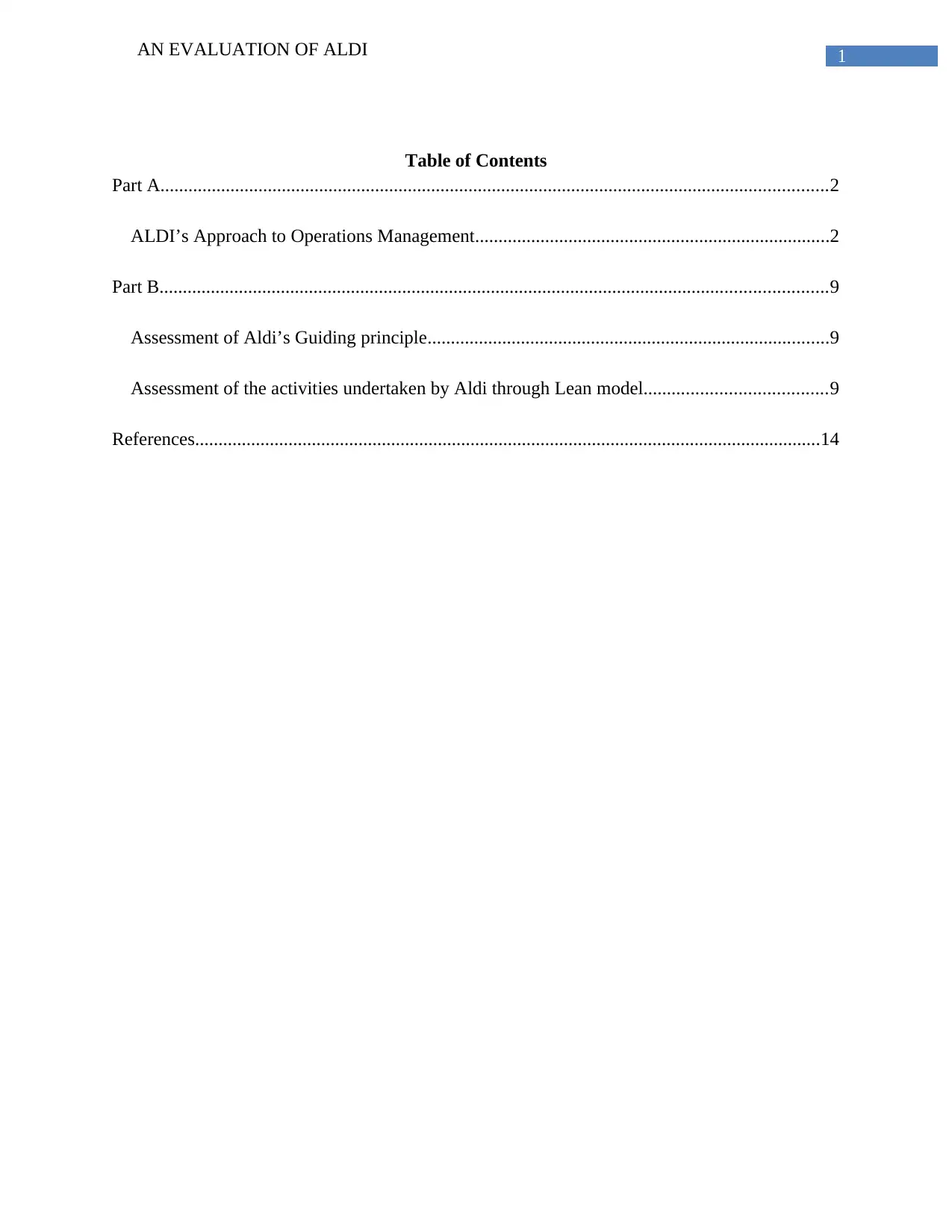
1AN EVALUATION OF ALDI
Table of Contents
Part A...............................................................................................................................................2
ALDI’s Approach to Operations Management............................................................................2
Part B...............................................................................................................................................9
Assessment of Aldi’s Guiding principle......................................................................................9
Assessment of the activities undertaken by Aldi through Lean model.......................................9
References......................................................................................................................................14
Table of Contents
Part A...............................................................................................................................................2
ALDI’s Approach to Operations Management............................................................................2
Part B...............................................................................................................................................9
Assessment of Aldi’s Guiding principle......................................................................................9
Assessment of the activities undertaken by Aldi through Lean model.......................................9
References......................................................................................................................................14
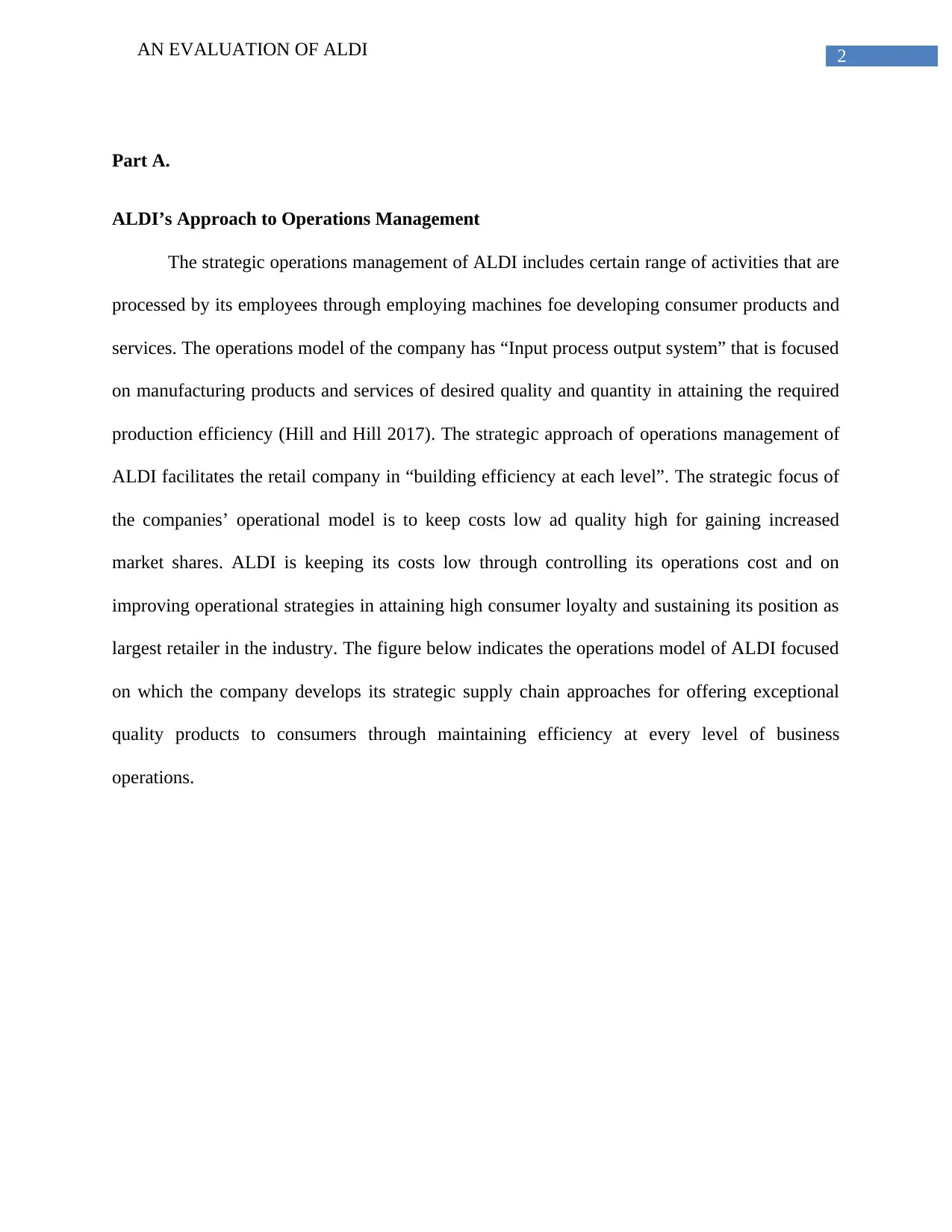
2AN EVALUATION OF ALDI
Part A.
ALDI’s Approach to Operations Management
The strategic operations management of ALDI includes certain range of activities that are
processed by its employees through employing machines foe developing consumer products and
services. The operations model of the company has “Input process output system” that is focused
on manufacturing products and services of desired quality and quantity in attaining the required
production efficiency (Hill and Hill 2017). The strategic approach of operations management of
ALDI facilitates the retail company in “building efficiency at each level”. The strategic focus of
the companies’ operational model is to keep costs low ad quality high for gaining increased
market shares. ALDI is keeping its costs low through controlling its operations cost and on
improving operational strategies in attaining high consumer loyalty and sustaining its position as
largest retailer in the industry. The figure below indicates the operations model of ALDI focused
on which the company develops its strategic supply chain approaches for offering exceptional
quality products to consumers through maintaining efficiency at every level of business
operations.
Part A.
ALDI’s Approach to Operations Management
The strategic operations management of ALDI includes certain range of activities that are
processed by its employees through employing machines foe developing consumer products and
services. The operations model of the company has “Input process output system” that is focused
on manufacturing products and services of desired quality and quantity in attaining the required
production efficiency (Hill and Hill 2017). The strategic approach of operations management of
ALDI facilitates the retail company in “building efficiency at each level”. The strategic focus of
the companies’ operational model is to keep costs low ad quality high for gaining increased
market shares. ALDI is keeping its costs low through controlling its operations cost and on
improving operational strategies in attaining high consumer loyalty and sustaining its position as
largest retailer in the industry. The figure below indicates the operations model of ALDI focused
on which the company develops its strategic supply chain approaches for offering exceptional
quality products to consumers through maintaining efficiency at every level of business
operations.
⊘ This is a preview!⊘
Do you want full access?
Subscribe today to unlock all pages.

Trusted by 1+ million students worldwide
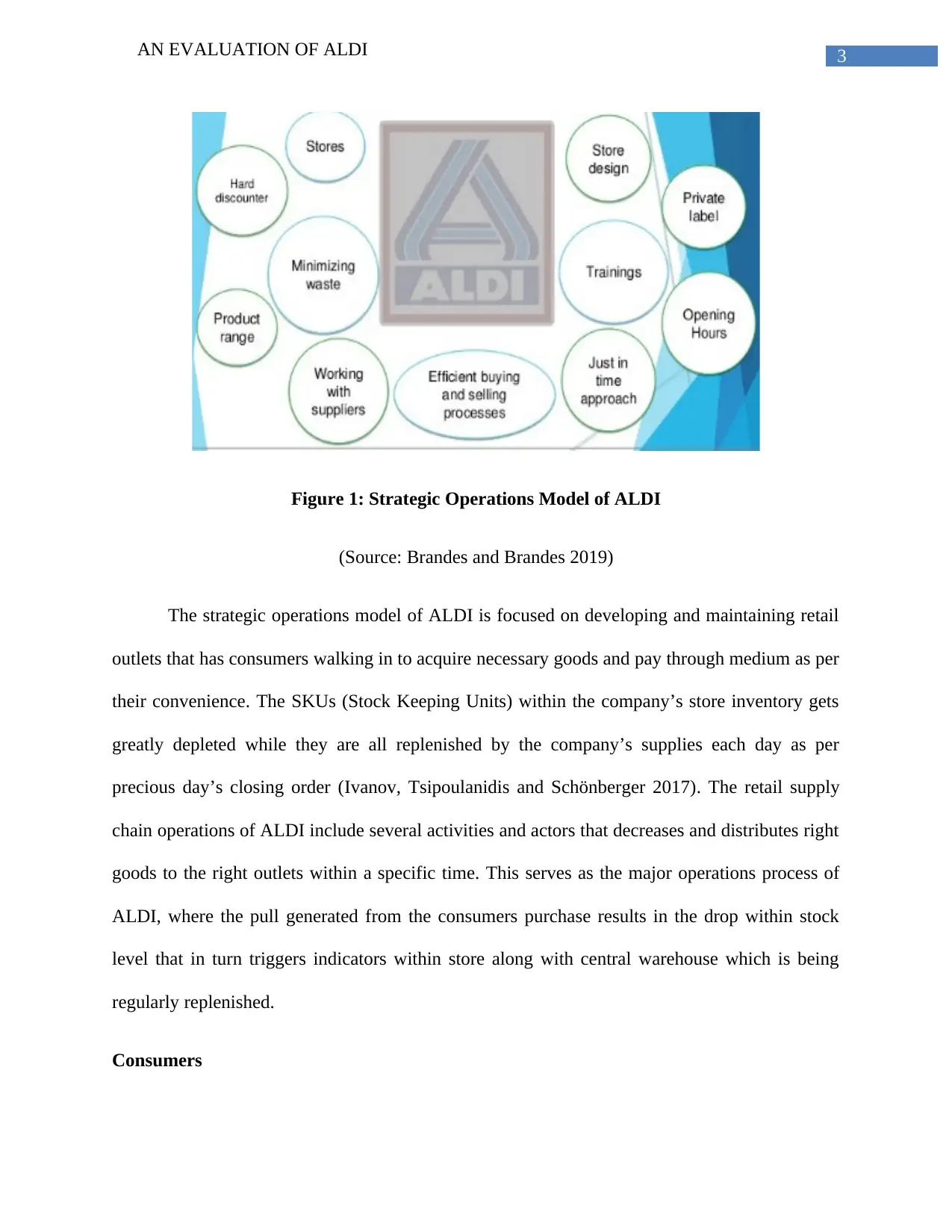
3AN EVALUATION OF ALDI
Figure 1: Strategic Operations Model of ALDI
(Source: Brandes and Brandes 2019)
The strategic operations model of ALDI is focused on developing and maintaining retail
outlets that has consumers walking in to acquire necessary goods and pay through medium as per
their convenience. The SKUs (Stock Keeping Units) within the company’s store inventory gets
greatly depleted while they are all replenished by the company’s supplies each day as per
precious day’s closing order (Ivanov, Tsipoulanidis and Schönberger 2017). The retail supply
chain operations of ALDI include several activities and actors that decreases and distributes right
goods to the right outlets within a specific time. This serves as the major operations process of
ALDI, where the pull generated from the consumers purchase results in the drop within stock
level that in turn triggers indicators within store along with central warehouse which is being
regularly replenished.
Consumers
Figure 1: Strategic Operations Model of ALDI
(Source: Brandes and Brandes 2019)
The strategic operations model of ALDI is focused on developing and maintaining retail
outlets that has consumers walking in to acquire necessary goods and pay through medium as per
their convenience. The SKUs (Stock Keeping Units) within the company’s store inventory gets
greatly depleted while they are all replenished by the company’s supplies each day as per
precious day’s closing order (Ivanov, Tsipoulanidis and Schönberger 2017). The retail supply
chain operations of ALDI include several activities and actors that decreases and distributes right
goods to the right outlets within a specific time. This serves as the major operations process of
ALDI, where the pull generated from the consumers purchase results in the drop within stock
level that in turn triggers indicators within store along with central warehouse which is being
regularly replenished.
Consumers
Paraphrase This Document
Need a fresh take? Get an instant paraphrase of this document with our AI Paraphraser
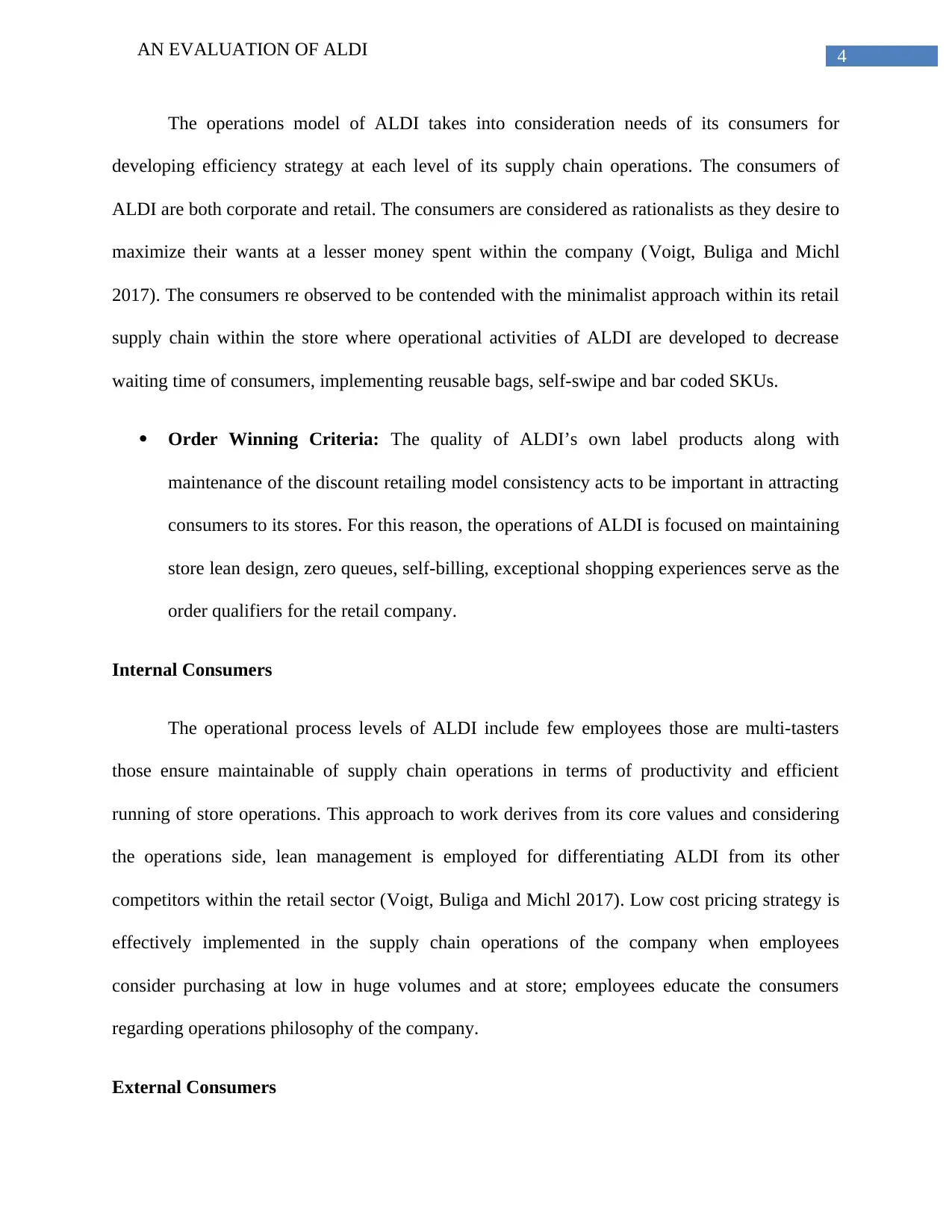
4AN EVALUATION OF ALDI
The operations model of ALDI takes into consideration needs of its consumers for
developing efficiency strategy at each level of its supply chain operations. The consumers of
ALDI are both corporate and retail. The consumers are considered as rationalists as they desire to
maximize their wants at a lesser money spent within the company (Voigt, Buliga and Michl
2017). The consumers re observed to be contended with the minimalist approach within its retail
supply chain within the store where operational activities of ALDI are developed to decrease
waiting time of consumers, implementing reusable bags, self-swipe and bar coded SKUs.
Order Winning Criteria: The quality of ALDI’s own label products along with
maintenance of the discount retailing model consistency acts to be important in attracting
consumers to its stores. For this reason, the operations of ALDI is focused on maintaining
store lean design, zero queues, self-billing, exceptional shopping experiences serve as the
order qualifiers for the retail company.
Internal Consumers
The operational process levels of ALDI include few employees those are multi-tasters
those ensure maintainable of supply chain operations in terms of productivity and efficient
running of store operations. This approach to work derives from its core values and considering
the operations side, lean management is employed for differentiating ALDI from its other
competitors within the retail sector (Voigt, Buliga and Michl 2017). Low cost pricing strategy is
effectively implemented in the supply chain operations of the company when employees
consider purchasing at low in huge volumes and at store; employees educate the consumers
regarding operations philosophy of the company.
External Consumers
The operations model of ALDI takes into consideration needs of its consumers for
developing efficiency strategy at each level of its supply chain operations. The consumers of
ALDI are both corporate and retail. The consumers are considered as rationalists as they desire to
maximize their wants at a lesser money spent within the company (Voigt, Buliga and Michl
2017). The consumers re observed to be contended with the minimalist approach within its retail
supply chain within the store where operational activities of ALDI are developed to decrease
waiting time of consumers, implementing reusable bags, self-swipe and bar coded SKUs.
Order Winning Criteria: The quality of ALDI’s own label products along with
maintenance of the discount retailing model consistency acts to be important in attracting
consumers to its stores. For this reason, the operations of ALDI is focused on maintaining
store lean design, zero queues, self-billing, exceptional shopping experiences serve as the
order qualifiers for the retail company.
Internal Consumers
The operational process levels of ALDI include few employees those are multi-tasters
those ensure maintainable of supply chain operations in terms of productivity and efficient
running of store operations. This approach to work derives from its core values and considering
the operations side, lean management is employed for differentiating ALDI from its other
competitors within the retail sector (Voigt, Buliga and Michl 2017). Low cost pricing strategy is
effectively implemented in the supply chain operations of the company when employees
consider purchasing at low in huge volumes and at store; employees educate the consumers
regarding operations philosophy of the company.
External Consumers
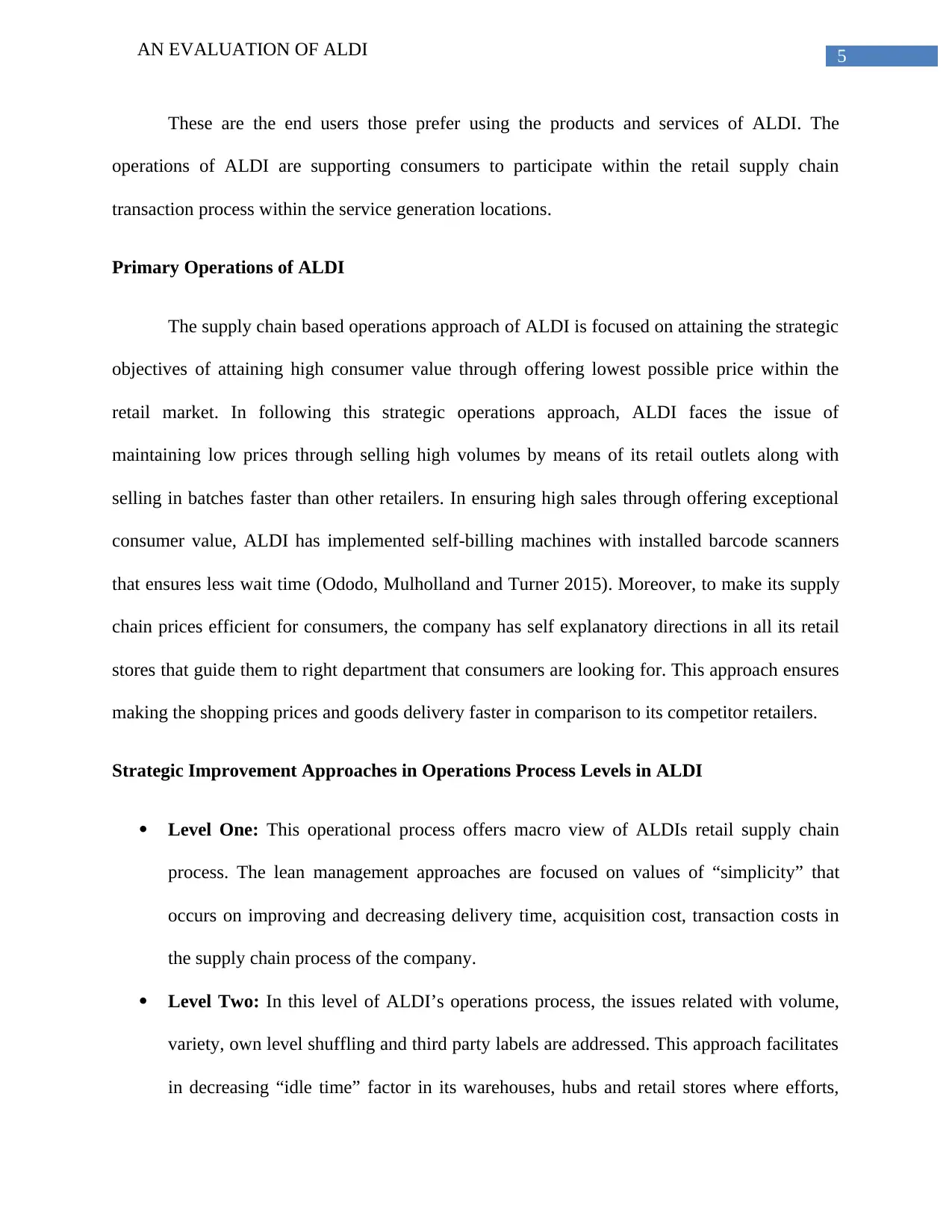
5AN EVALUATION OF ALDI
These are the end users those prefer using the products and services of ALDI. The
operations of ALDI are supporting consumers to participate within the retail supply chain
transaction process within the service generation locations.
Primary Operations of ALDI
The supply chain based operations approach of ALDI is focused on attaining the strategic
objectives of attaining high consumer value through offering lowest possible price within the
retail market. In following this strategic operations approach, ALDI faces the issue of
maintaining low prices through selling high volumes by means of its retail outlets along with
selling in batches faster than other retailers. In ensuring high sales through offering exceptional
consumer value, ALDI has implemented self-billing machines with installed barcode scanners
that ensures less wait time (Ododo, Mulholland and Turner 2015). Moreover, to make its supply
chain prices efficient for consumers, the company has self explanatory directions in all its retail
stores that guide them to right department that consumers are looking for. This approach ensures
making the shopping prices and goods delivery faster in comparison to its competitor retailers.
Strategic Improvement Approaches in Operations Process Levels in ALDI
Level One: This operational process offers macro view of ALDIs retail supply chain
process. The lean management approaches are focused on values of “simplicity” that
occurs on improving and decreasing delivery time, acquisition cost, transaction costs in
the supply chain process of the company.
Level Two: In this level of ALDI’s operations process, the issues related with volume,
variety, own level shuffling and third party labels are addressed. This approach facilitates
in decreasing “idle time” factor in its warehouses, hubs and retail stores where efforts,
These are the end users those prefer using the products and services of ALDI. The
operations of ALDI are supporting consumers to participate within the retail supply chain
transaction process within the service generation locations.
Primary Operations of ALDI
The supply chain based operations approach of ALDI is focused on attaining the strategic
objectives of attaining high consumer value through offering lowest possible price within the
retail market. In following this strategic operations approach, ALDI faces the issue of
maintaining low prices through selling high volumes by means of its retail outlets along with
selling in batches faster than other retailers. In ensuring high sales through offering exceptional
consumer value, ALDI has implemented self-billing machines with installed barcode scanners
that ensures less wait time (Ododo, Mulholland and Turner 2015). Moreover, to make its supply
chain prices efficient for consumers, the company has self explanatory directions in all its retail
stores that guide them to right department that consumers are looking for. This approach ensures
making the shopping prices and goods delivery faster in comparison to its competitor retailers.
Strategic Improvement Approaches in Operations Process Levels in ALDI
Level One: This operational process offers macro view of ALDIs retail supply chain
process. The lean management approaches are focused on values of “simplicity” that
occurs on improving and decreasing delivery time, acquisition cost, transaction costs in
the supply chain process of the company.
Level Two: In this level of ALDI’s operations process, the issues related with volume,
variety, own level shuffling and third party labels are addressed. This approach facilitates
in decreasing “idle time” factor in its warehouses, hubs and retail stores where efforts,
⊘ This is a preview!⊘
Do you want full access?
Subscribe today to unlock all pages.

Trusted by 1+ million students worldwide
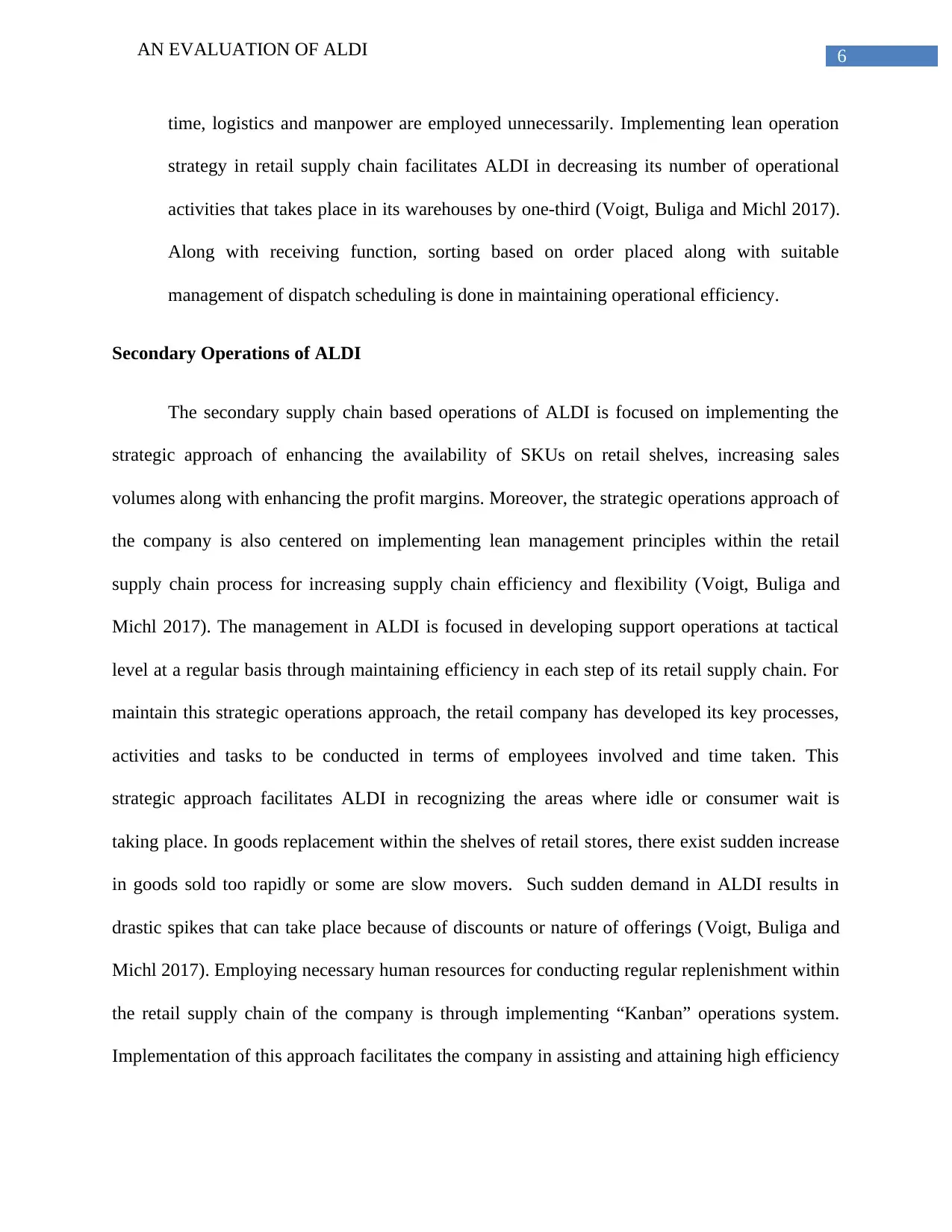
6AN EVALUATION OF ALDI
time, logistics and manpower are employed unnecessarily. Implementing lean operation
strategy in retail supply chain facilitates ALDI in decreasing its number of operational
activities that takes place in its warehouses by one-third (Voigt, Buliga and Michl 2017).
Along with receiving function, sorting based on order placed along with suitable
management of dispatch scheduling is done in maintaining operational efficiency.
Secondary Operations of ALDI
The secondary supply chain based operations of ALDI is focused on implementing the
strategic approach of enhancing the availability of SKUs on retail shelves, increasing sales
volumes along with enhancing the profit margins. Moreover, the strategic operations approach of
the company is also centered on implementing lean management principles within the retail
supply chain process for increasing supply chain efficiency and flexibility (Voigt, Buliga and
Michl 2017). The management in ALDI is focused in developing support operations at tactical
level at a regular basis through maintaining efficiency in each step of its retail supply chain. For
maintain this strategic operations approach, the retail company has developed its key processes,
activities and tasks to be conducted in terms of employees involved and time taken. This
strategic approach facilitates ALDI in recognizing the areas where idle or consumer wait is
taking place. In goods replacement within the shelves of retail stores, there exist sudden increase
in goods sold too rapidly or some are slow movers. Such sudden demand in ALDI results in
drastic spikes that can take place because of discounts or nature of offerings (Voigt, Buliga and
Michl 2017). Employing necessary human resources for conducting regular replenishment within
the retail supply chain of the company is through implementing “Kanban” operations system.
Implementation of this approach facilitates the company in assisting and attaining high efficiency
time, logistics and manpower are employed unnecessarily. Implementing lean operation
strategy in retail supply chain facilitates ALDI in decreasing its number of operational
activities that takes place in its warehouses by one-third (Voigt, Buliga and Michl 2017).
Along with receiving function, sorting based on order placed along with suitable
management of dispatch scheduling is done in maintaining operational efficiency.
Secondary Operations of ALDI
The secondary supply chain based operations of ALDI is focused on implementing the
strategic approach of enhancing the availability of SKUs on retail shelves, increasing sales
volumes along with enhancing the profit margins. Moreover, the strategic operations approach of
the company is also centered on implementing lean management principles within the retail
supply chain process for increasing supply chain efficiency and flexibility (Voigt, Buliga and
Michl 2017). The management in ALDI is focused in developing support operations at tactical
level at a regular basis through maintaining efficiency in each step of its retail supply chain. For
maintain this strategic operations approach, the retail company has developed its key processes,
activities and tasks to be conducted in terms of employees involved and time taken. This
strategic approach facilitates ALDI in recognizing the areas where idle or consumer wait is
taking place. In goods replacement within the shelves of retail stores, there exist sudden increase
in goods sold too rapidly or some are slow movers. Such sudden demand in ALDI results in
drastic spikes that can take place because of discounts or nature of offerings (Voigt, Buliga and
Michl 2017). Employing necessary human resources for conducting regular replenishment within
the retail supply chain of the company is through implementing “Kanban” operations system.
Implementation of this approach facilitates the company in assisting and attaining high efficiency
Paraphrase This Document
Need a fresh take? Get an instant paraphrase of this document with our AI Paraphraser
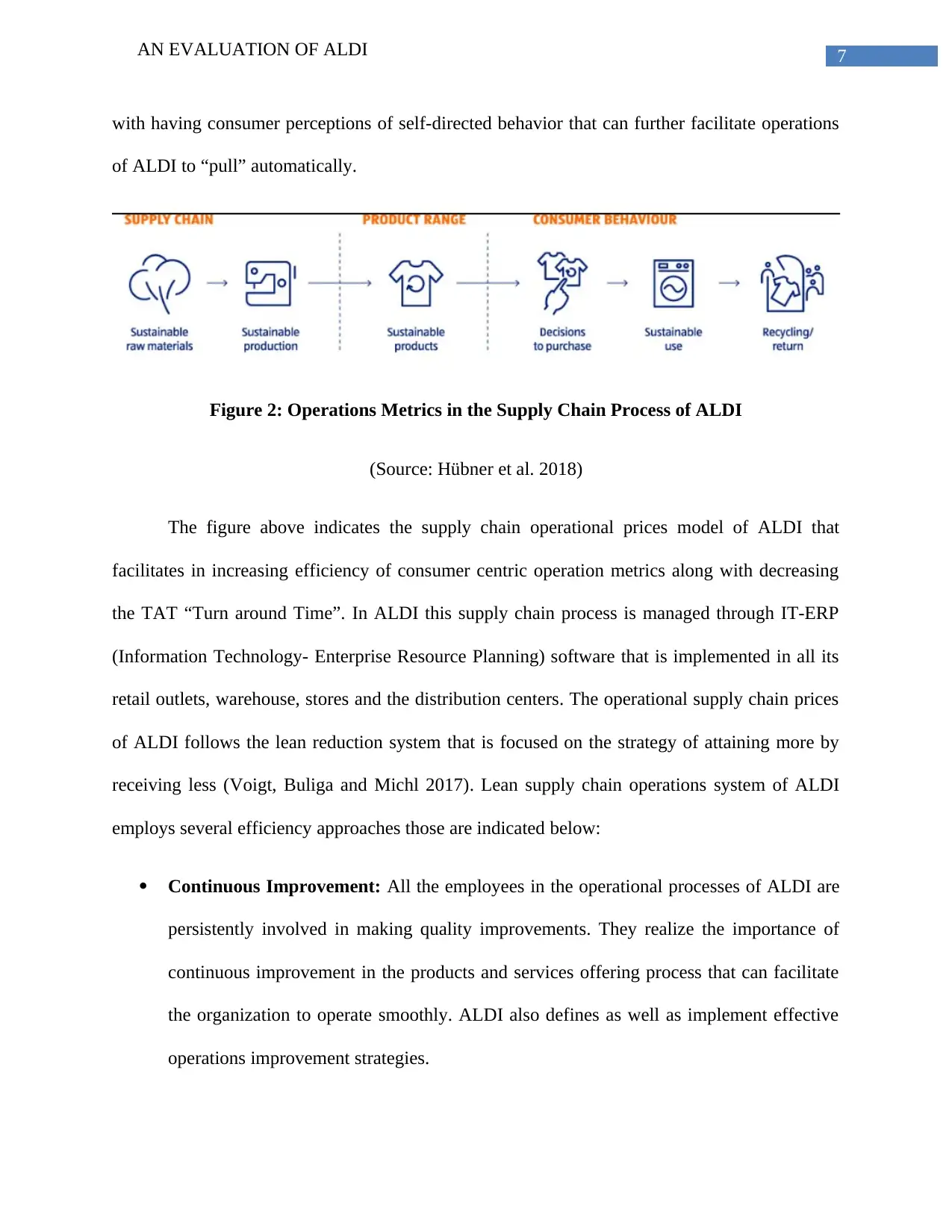
7AN EVALUATION OF ALDI
with having consumer perceptions of self-directed behavior that can further facilitate operations
of ALDI to “pull” automatically.
Figure 2: Operations Metrics in the Supply Chain Process of ALDI
(Source: Hübner et al. 2018)
The figure above indicates the supply chain operational prices model of ALDI that
facilitates in increasing efficiency of consumer centric operation metrics along with decreasing
the TAT “Turn around Time”. In ALDI this supply chain process is managed through IT-ERP
(Information Technology- Enterprise Resource Planning) software that is implemented in all its
retail outlets, warehouse, stores and the distribution centers. The operational supply chain prices
of ALDI follows the lean reduction system that is focused on the strategy of attaining more by
receiving less (Voigt, Buliga and Michl 2017). Lean supply chain operations system of ALDI
employs several efficiency approaches those are indicated below:
Continuous Improvement: All the employees in the operational processes of ALDI are
persistently involved in making quality improvements. They realize the importance of
continuous improvement in the products and services offering process that can facilitate
the organization to operate smoothly. ALDI also defines as well as implement effective
operations improvement strategies.
with having consumer perceptions of self-directed behavior that can further facilitate operations
of ALDI to “pull” automatically.
Figure 2: Operations Metrics in the Supply Chain Process of ALDI
(Source: Hübner et al. 2018)
The figure above indicates the supply chain operational prices model of ALDI that
facilitates in increasing efficiency of consumer centric operation metrics along with decreasing
the TAT “Turn around Time”. In ALDI this supply chain process is managed through IT-ERP
(Information Technology- Enterprise Resource Planning) software that is implemented in all its
retail outlets, warehouse, stores and the distribution centers. The operational supply chain prices
of ALDI follows the lean reduction system that is focused on the strategy of attaining more by
receiving less (Voigt, Buliga and Michl 2017). Lean supply chain operations system of ALDI
employs several efficiency approaches those are indicated below:
Continuous Improvement: All the employees in the operational processes of ALDI are
persistently involved in making quality improvements. They realize the importance of
continuous improvement in the products and services offering process that can facilitate
the organization to operate smoothly. ALDI also defines as well as implement effective
operations improvement strategies.
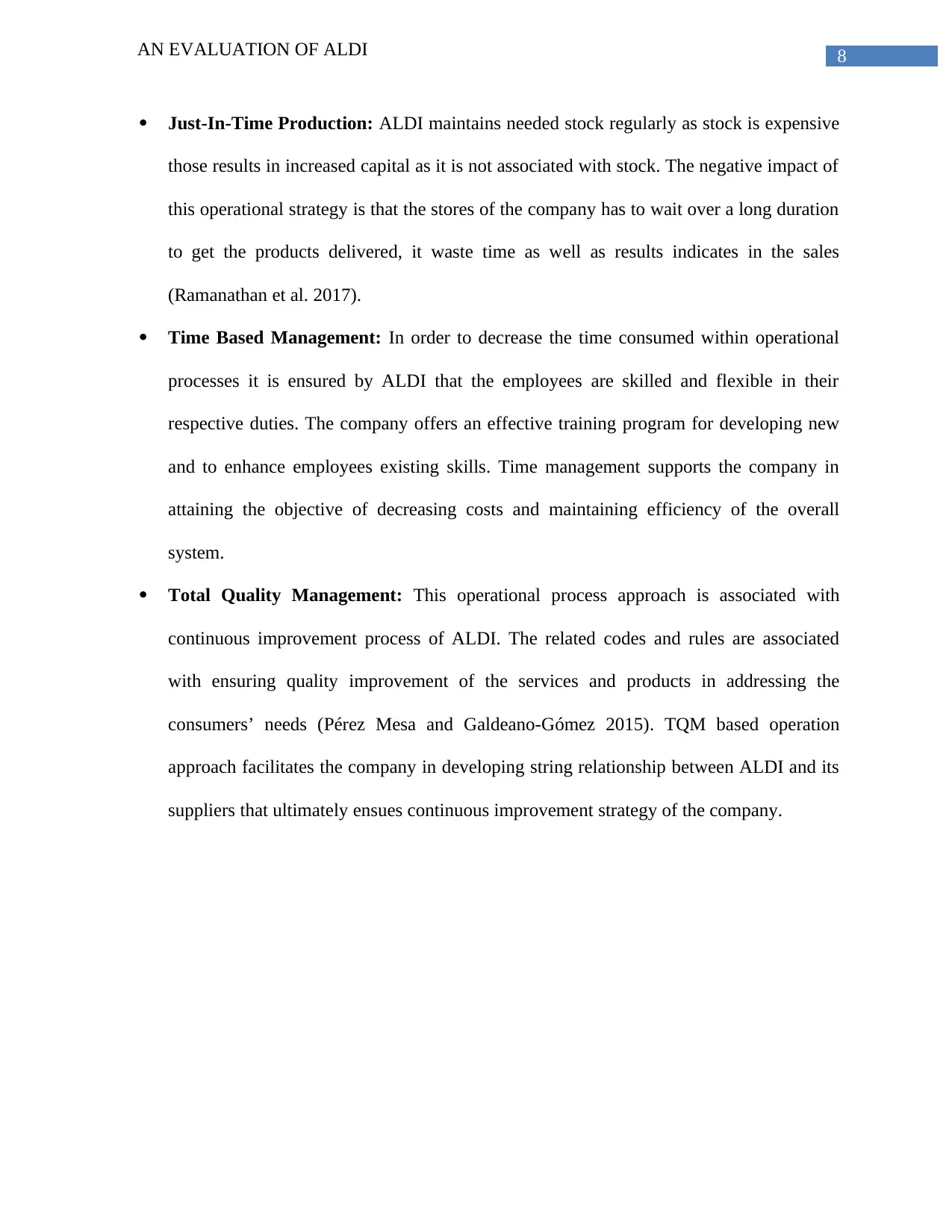
8AN EVALUATION OF ALDI
Just-In-Time Production: ALDI maintains needed stock regularly as stock is expensive
those results in increased capital as it is not associated with stock. The negative impact of
this operational strategy is that the stores of the company has to wait over a long duration
to get the products delivered, it waste time as well as results indicates in the sales
(Ramanathan et al. 2017).
Time Based Management: In order to decrease the time consumed within operational
processes it is ensured by ALDI that the employees are skilled and flexible in their
respective duties. The company offers an effective training program for developing new
and to enhance employees existing skills. Time management supports the company in
attaining the objective of decreasing costs and maintaining efficiency of the overall
system.
Total Quality Management: This operational process approach is associated with
continuous improvement process of ALDI. The related codes and rules are associated
with ensuring quality improvement of the services and products in addressing the
consumers’ needs (Pérez Mesa and Galdeano-Gómez 2015). TQM based operation
approach facilitates the company in developing string relationship between ALDI and its
suppliers that ultimately ensues continuous improvement strategy of the company.
Just-In-Time Production: ALDI maintains needed stock regularly as stock is expensive
those results in increased capital as it is not associated with stock. The negative impact of
this operational strategy is that the stores of the company has to wait over a long duration
to get the products delivered, it waste time as well as results indicates in the sales
(Ramanathan et al. 2017).
Time Based Management: In order to decrease the time consumed within operational
processes it is ensured by ALDI that the employees are skilled and flexible in their
respective duties. The company offers an effective training program for developing new
and to enhance employees existing skills. Time management supports the company in
attaining the objective of decreasing costs and maintaining efficiency of the overall
system.
Total Quality Management: This operational process approach is associated with
continuous improvement process of ALDI. The related codes and rules are associated
with ensuring quality improvement of the services and products in addressing the
consumers’ needs (Pérez Mesa and Galdeano-Gómez 2015). TQM based operation
approach facilitates the company in developing string relationship between ALDI and its
suppliers that ultimately ensues continuous improvement strategy of the company.
⊘ This is a preview!⊘
Do you want full access?
Subscribe today to unlock all pages.

Trusted by 1+ million students worldwide
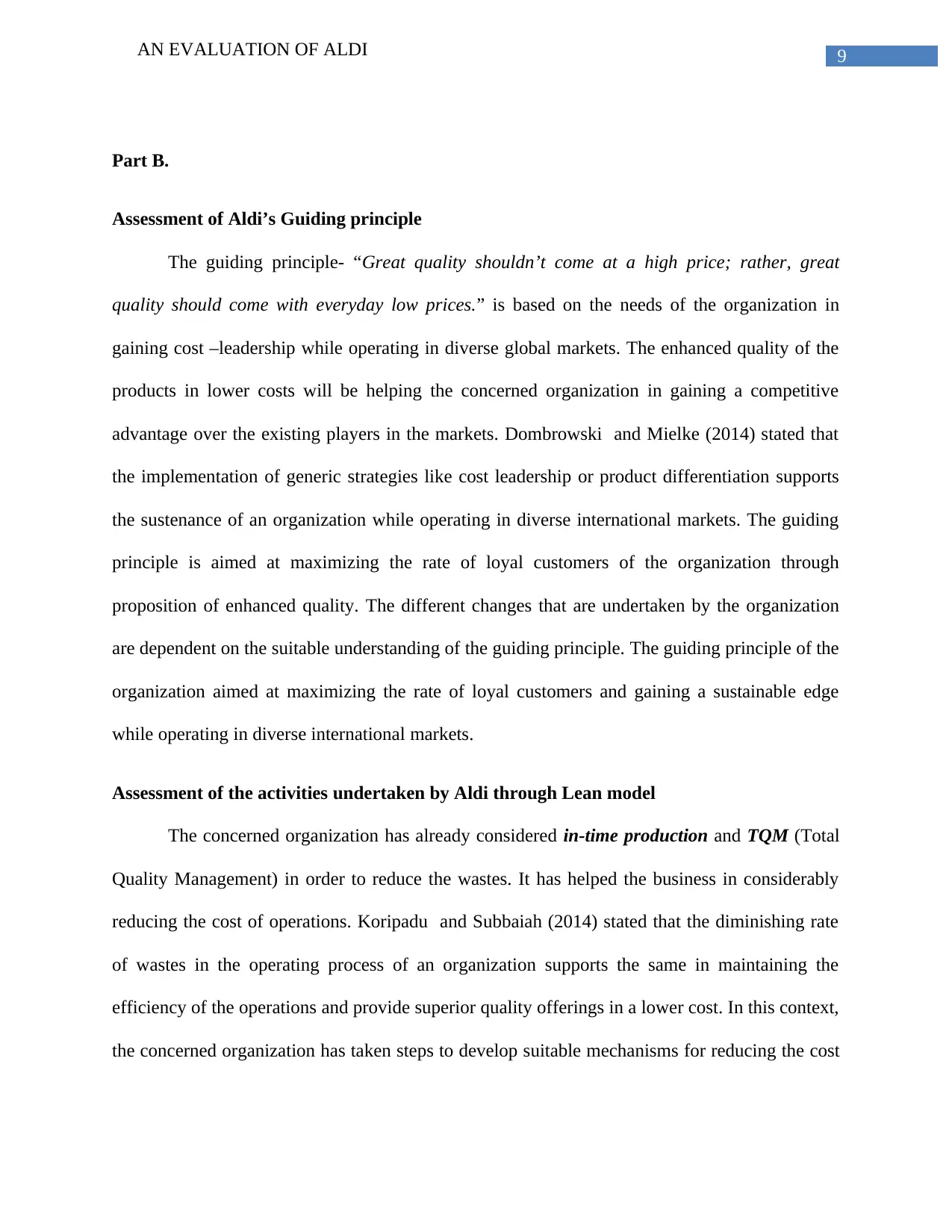
9AN EVALUATION OF ALDI
Part B.
Assessment of Aldi’s Guiding principle
The guiding principle- “Great quality shouldn’t come at a high price; rather, great
quality should come with everyday low prices.” is based on the needs of the organization in
gaining cost –leadership while operating in diverse global markets. The enhanced quality of the
products in lower costs will be helping the concerned organization in gaining a competitive
advantage over the existing players in the markets. Dombrowski and Mielke (2014) stated that
the implementation of generic strategies like cost leadership or product differentiation supports
the sustenance of an organization while operating in diverse international markets. The guiding
principle is aimed at maximizing the rate of loyal customers of the organization through
proposition of enhanced quality. The different changes that are undertaken by the organization
are dependent on the suitable understanding of the guiding principle. The guiding principle of the
organization aimed at maximizing the rate of loyal customers and gaining a sustainable edge
while operating in diverse international markets.
Assessment of the activities undertaken by Aldi through Lean model
The concerned organization has already considered in-time production and TQM (Total
Quality Management) in order to reduce the wastes. It has helped the business in considerably
reducing the cost of operations. Koripadu and Subbaiah (2014) stated that the diminishing rate
of wastes in the operating process of an organization supports the same in maintaining the
efficiency of the operations and provide superior quality offerings in a lower cost. In this context,
the concerned organization has taken steps to develop suitable mechanisms for reducing the cost
Part B.
Assessment of Aldi’s Guiding principle
The guiding principle- “Great quality shouldn’t come at a high price; rather, great
quality should come with everyday low prices.” is based on the needs of the organization in
gaining cost –leadership while operating in diverse global markets. The enhanced quality of the
products in lower costs will be helping the concerned organization in gaining a competitive
advantage over the existing players in the markets. Dombrowski and Mielke (2014) stated that
the implementation of generic strategies like cost leadership or product differentiation supports
the sustenance of an organization while operating in diverse international markets. The guiding
principle is aimed at maximizing the rate of loyal customers of the organization through
proposition of enhanced quality. The different changes that are undertaken by the organization
are dependent on the suitable understanding of the guiding principle. The guiding principle of the
organization aimed at maximizing the rate of loyal customers and gaining a sustainable edge
while operating in diverse international markets.
Assessment of the activities undertaken by Aldi through Lean model
The concerned organization has already considered in-time production and TQM (Total
Quality Management) in order to reduce the wastes. It has helped the business in considerably
reducing the cost of operations. Koripadu and Subbaiah (2014) stated that the diminishing rate
of wastes in the operating process of an organization supports the same in maintaining the
efficiency of the operations and provide superior quality offerings in a lower cost. In this context,
the concerned organization has taken steps to develop suitable mechanisms for reducing the cost
Paraphrase This Document
Need a fresh take? Get an instant paraphrase of this document with our AI Paraphraser
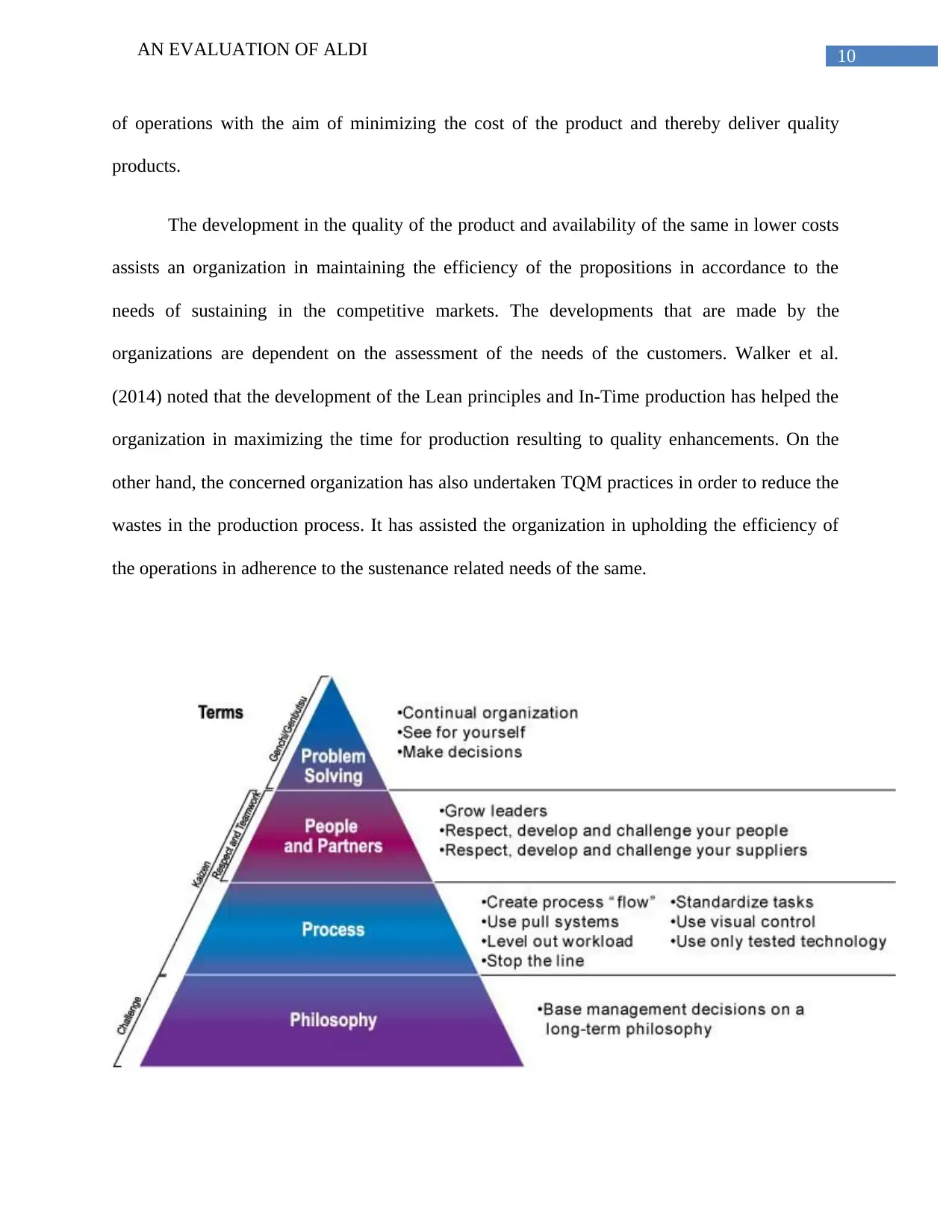
10AN EVALUATION OF ALDI
of operations with the aim of minimizing the cost of the product and thereby deliver quality
products.
The development in the quality of the product and availability of the same in lower costs
assists an organization in maintaining the efficiency of the propositions in accordance to the
needs of sustaining in the competitive markets. The developments that are made by the
organizations are dependent on the assessment of the needs of the customers. Walker et al.
(2014) noted that the development of the Lean principles and In-Time production has helped the
organization in maximizing the time for production resulting to quality enhancements. On the
other hand, the concerned organization has also undertaken TQM practices in order to reduce the
wastes in the production process. It has assisted the organization in upholding the efficiency of
the operations in adherence to the sustenance related needs of the same.
of operations with the aim of minimizing the cost of the product and thereby deliver quality
products.
The development in the quality of the product and availability of the same in lower costs
assists an organization in maintaining the efficiency of the propositions in accordance to the
needs of sustaining in the competitive markets. The developments that are made by the
organizations are dependent on the assessment of the needs of the customers. Walker et al.
(2014) noted that the development of the Lean principles and In-Time production has helped the
organization in maximizing the time for production resulting to quality enhancements. On the
other hand, the concerned organization has also undertaken TQM practices in order to reduce the
wastes in the production process. It has assisted the organization in upholding the efficiency of
the operations in adherence to the sustenance related needs of the same.
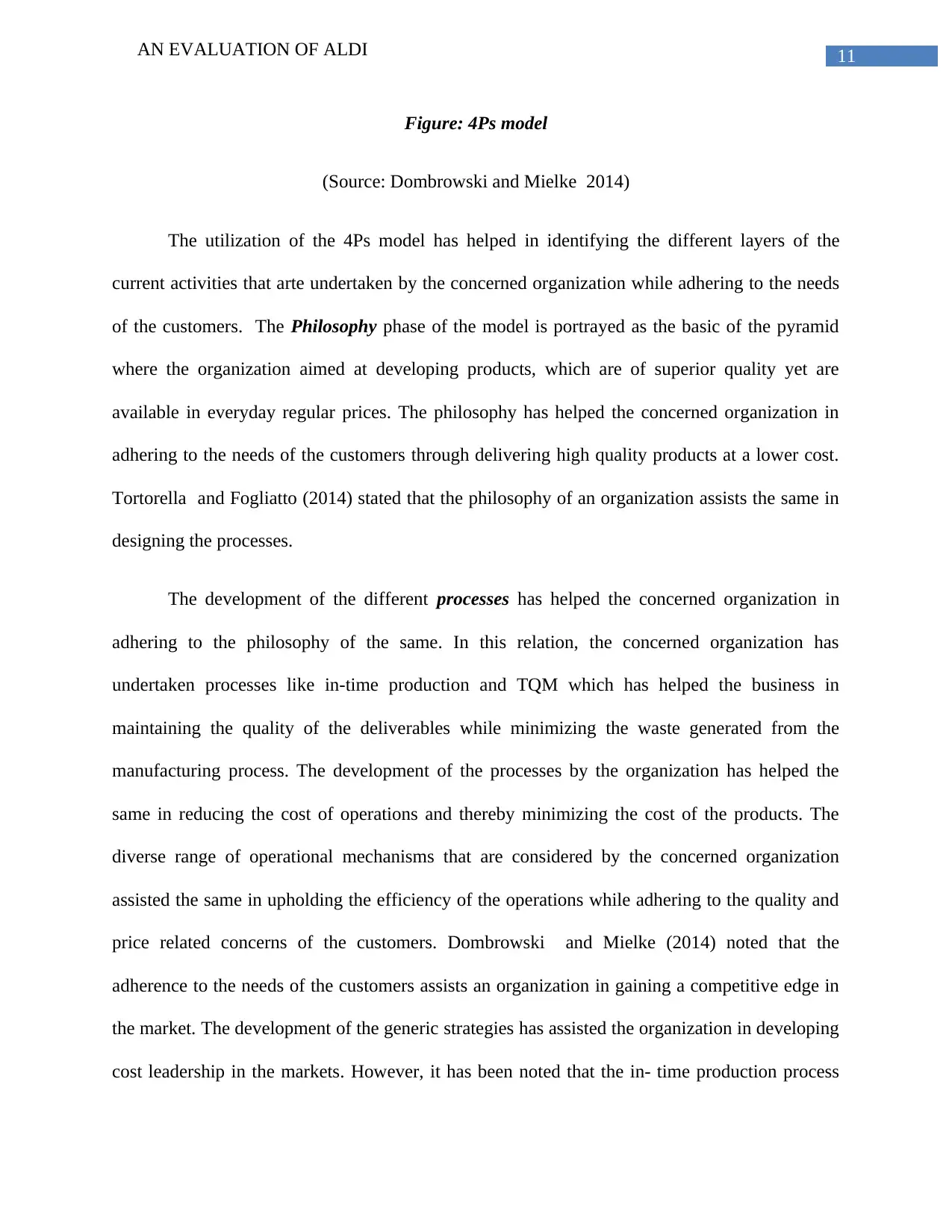
11AN EVALUATION OF ALDI
Figure: 4Ps model
(Source: Dombrowski and Mielke 2014)
The utilization of the 4Ps model has helped in identifying the different layers of the
current activities that arte undertaken by the concerned organization while adhering to the needs
of the customers. The Philosophy phase of the model is portrayed as the basic of the pyramid
where the organization aimed at developing products, which are of superior quality yet are
available in everyday regular prices. The philosophy has helped the concerned organization in
adhering to the needs of the customers through delivering high quality products at a lower cost.
Tortorella and Fogliatto (2014) stated that the philosophy of an organization assists the same in
designing the processes.
The development of the different processes has helped the concerned organization in
adhering to the philosophy of the same. In this relation, the concerned organization has
undertaken processes like in-time production and TQM which has helped the business in
maintaining the quality of the deliverables while minimizing the waste generated from the
manufacturing process. The development of the processes by the organization has helped the
same in reducing the cost of operations and thereby minimizing the cost of the products. The
diverse range of operational mechanisms that are considered by the concerned organization
assisted the same in upholding the efficiency of the operations while adhering to the quality and
price related concerns of the customers. Dombrowski and Mielke (2014) noted that the
adherence to the needs of the customers assists an organization in gaining a competitive edge in
the market. The development of the generic strategies has assisted the organization in developing
cost leadership in the markets. However, it has been noted that the in- time production process
Figure: 4Ps model
(Source: Dombrowski and Mielke 2014)
The utilization of the 4Ps model has helped in identifying the different layers of the
current activities that arte undertaken by the concerned organization while adhering to the needs
of the customers. The Philosophy phase of the model is portrayed as the basic of the pyramid
where the organization aimed at developing products, which are of superior quality yet are
available in everyday regular prices. The philosophy has helped the concerned organization in
adhering to the needs of the customers through delivering high quality products at a lower cost.
Tortorella and Fogliatto (2014) stated that the philosophy of an organization assists the same in
designing the processes.
The development of the different processes has helped the concerned organization in
adhering to the philosophy of the same. In this relation, the concerned organization has
undertaken processes like in-time production and TQM which has helped the business in
maintaining the quality of the deliverables while minimizing the waste generated from the
manufacturing process. The development of the processes by the organization has helped the
same in reducing the cost of operations and thereby minimizing the cost of the products. The
diverse range of operational mechanisms that are considered by the concerned organization
assisted the same in upholding the efficiency of the operations while adhering to the quality and
price related concerns of the customers. Dombrowski and Mielke (2014) noted that the
adherence to the needs of the customers assists an organization in gaining a competitive edge in
the market. The development of the generic strategies has assisted the organization in developing
cost leadership in the markets. However, it has been noted that the in- time production process
⊘ This is a preview!⊘
Do you want full access?
Subscribe today to unlock all pages.

Trusted by 1+ million students worldwide
1 out of 17
Related Documents
Your All-in-One AI-Powered Toolkit for Academic Success.
+13062052269
info@desklib.com
Available 24*7 on WhatsApp / Email
![[object Object]](/_next/static/media/star-bottom.7253800d.svg)
Unlock your academic potential
Copyright © 2020–2025 A2Z Services. All Rights Reserved. Developed and managed by ZUCOL.





